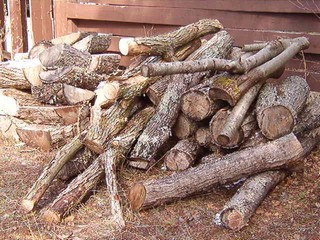Wood turning lathes seem to eat up the wood supply. One of the first difficulties encountered by a new turner is where to get the wood to turn. Most grab a 2x4, cut it to a 2x2 and turn it round. This gets tired fast. Firewood is available in most communities. A quick look at the local ads or net boards like Kijiji usually points out a couple of suppliers at least. In some areas the sound of a chainsaw may indicate tree care companies at work and some of them leave wood at the road side for people to pick up. Others sell it as firewood. It is fairly cheap, hardwood instead of softwood, certainly a lot better priced than finished, kiln dried boards, and in more suitable shapes for turners. That said the question is what to do with it to prepare it for turning. Let us have a look at making up a bowl blank.
Bowls from Firewood to Finished
Most of my bowl blanks are found first as firewood or landfill and with a bit of work turn into bowls and lots of other turnings.
Consider that fire wood is generally sold by the cord (a 4' by 4' by 8' stack or 128 cubic feet). Say you get a cord of firewood and want to turn bowls, vases, candle sticks, spurtles and stuff. A cord of wood is a lot of wood. Certainly enough for 100 bowls and vases each with lots left over for spindle turning and allowing for a third waste, much of which can be turned. This needs to be transformed from log length of 8 feet or stove length of 16 inches to usable wood. Just a thought on buying. People who sell firewood by the 8' length are used to selling a minimum of 4 cords or more and have trucks and such to handle it. Four cords of wood is a lot of turning and may rot before you get to it. People who sell wood in 16" lengths are used to selling it "cut, dried and split." We are a pain to either. What is generally ideal for a wood turner is four to eight foot lengths as freshly cut as possible. Considering how cheap the wood is compared to hardwood lumber, a few dollars premium to the supplier may be a good idea.
The reason I mention all the things you can do with a cord of wood and the obvious cost savings, is simply that you need a chain saw and part of the savings go for it. For shop purposes an electric will do and unless you have lots of disposable income, Electrolux makes most of the electrics on the market, usually under the Poulan label but also lots of others. Get a 16" with about a 12 amp or better motor. If you use it at any distance from an outlet, say longer than eight feet, get an extension cord of at least 14 guage and twelve or even ten is better. Wear appropriate safety gear. I make no claims and take no responsibility for safe chain saw use. This is one of the most dangerous tools known to man. I have used one since I was a young lad, and it still scares me silly or at least engenders a lot of respect. It is also a virtual necessity for turners unless you plan on buying some very expensive, pre-cut blanks for the rest of your turning career. If you buy the saw from a reputable dealer they will know someone who can give you some intruction on how to use it safely.

Step one is to coat all ends with log sealer such as Anchorseal™ or the like. This will help slow down cracking and the loss of the wood due to splits People will use all kinds of things like old paint or white glue instead but do yourself a favor and use a good end grain sealer like the hardwood mill people do because they like to save money by doing right.. I buy Anchorseal™ in a five gallon bucket and pour it into a convenient pitcher for easy carrying and use. In the pitcher lives a brush for application. I cut the handle a bit so the cover fits on. Just paint the ends of the logs. Incidentally I notice that U-C Coatings has a new Anchorseal 2™ product that is more enviromentally friendly. I will have to try this out. If you live in an area that goes cold in winter (we can hit -30°C) get the winterized version.

Here is a woodpile in the yard. This is pretty typical in my experience for a woodturner who likes to make bowls. I tend to order the wood in six inch or larger diameter and eight foot lengths. Occasionaly I can get lengths like this which are random and have the stuff most people do not want like crotch wood and the like.

Some of the wood has been cut into half logs for bowls, some more into blocks and still more into slabs for various wood turning projects. The ends are treated with Anchorseal™ to slow down splitting as I may not get to all the pieces for a while.
